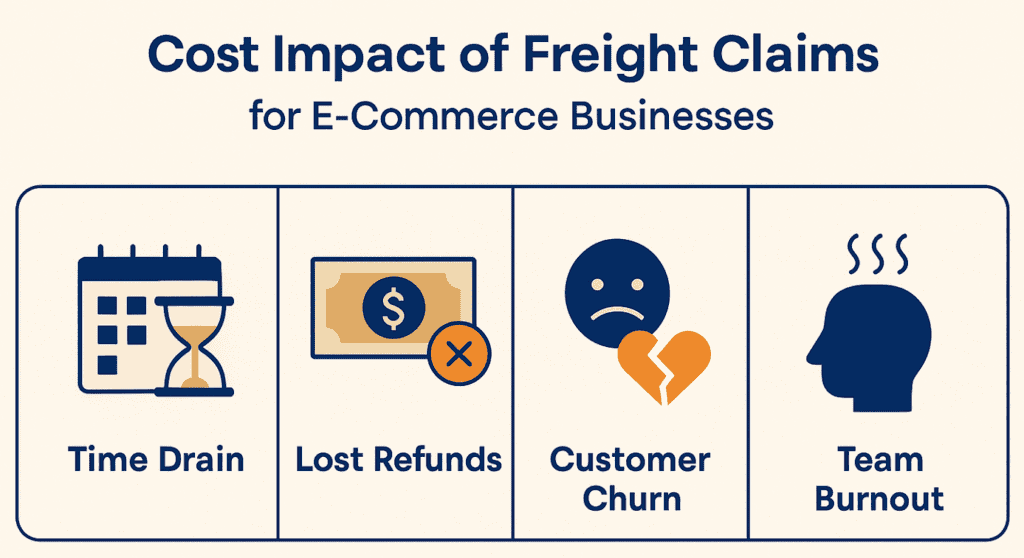Freight claims aren’t just a logistics issue — they directly impact customer experience and margins, and growth potential. In e-commerce, even a single lost or damaged parcel can mean losing a loyal customer.
Managing freight claims isn’t optional. It’s critical to protecting your brand reputation and your bottom line. And while many businesses still rely on manual emails and spreadsheets to track claims, there’s a smarter, faster way to stay in control.
Let’s dive into what freight claims are, why they matter in e-commerce, and how smart claim management protects your bottom line and unlocks long-term growth.
What is a freight claim?
A freight claim is a financial request submitted to a courier to recover losses caused by a damaged, lost, delayed, or overcharged shipment. Freight claims are also known as shipping claims, transportation claims or cargo claims.
For e-commerce merchants, freight claims aren’t rare, they’re (unfortunately) part of daily operations. Every delayed parcel, every damaged box, and every wrong invoice affects your profits and your customer satisfaction.
Common reasons why e-commerce shippers file freight claims
Handling freight claims is everyday business for e-commerce shippers. Here are the most common reasons:
- Loss: Parcels lost during transit — your customer never receives their order.
- Damage: Goods arrive broken or unusable due to rough handling, leading to return requests and negative reviews.
- Delay: Deliveries that arrive late, breaking the trust customers place in your brand.
- Overcharges: Incorrect weight or volume calculations resulting in unexpected shipping costs.
The costs of freight claims for e-commerce businesses
Freight claims don’t just cause headaches — they cause serious financial and operational pain.
Take the example of a mid-sized e-commerce brand shipping 10,000 parcels per month. If just 2.5% of shipments face issues, that’s 250 problems to track down, customers to update, refunds to chase, and internal workflows to coordinate. Manually. Each missed refund, each delayed claim, and each frustrated customer chips away at the brand’s profits and reputation.
Without the right systems, freight claims quietly become one of the most expensive hidden costs in e-commerce:
Time drain
Each claim can take hours to document, file, and chase. Multiply that by hundreds of shipments, and manual claims become a major hidden cost.
Lost refunds
Missed deadlines, incomplete evidence, or forgotten follow-ups often mean you don’t recover what you’re owed.
Customer churn risk
Slow resolutions frustrate customers, who may never come back after a bad delivery experience.
Team burnout
Support agents stuck in endless claim-chasing loops get overwhelmed, leading to high turnover and training costs.
Missed optimisation opportunities
Without centralised claims data, businesses can’t spot patterns, negotiate better courier contracts, or fix systemic shipping problems.
Difference between freight claims in B2B vs. e-commerce contexts
Freight claims exist across industries, but the way they affect e-commerce is unique.
| Aspect | B2B Freight Claims | E-commerce Freight Claims |
|---|---|---|
| Shipment Type | Bulk shipments (pallets, containers, full truckloads) | Individual parcels at high frequency |
| Shipment Value | High value per load, low frequency | Lower value per shipment, high frequency |
| Claim Management | Managed by logistics departments | Managed by CS agents, operations, or founders |
| Contract Type | Custom-negotiated logistics contracts | Standard courier terms, less leverage |
In short: In B2B, freight claims are rare but high-stakes. In e-commerce, freight claims are frequent and operationally critical.
Importance of understanding your courier contracts and SLAs
As a merchant, your agreements with couriers — your contracts and SLAs (Service Level Agreements) — are critical to managing claims effectively.
What contracts and SLAs define:
- Claim deadlines (7, 14, or 30 days to file)
- Types of accepted claims (loss, damage, sometimes not delays)
- Liability limits (standard caps unless declared otherwise)
- Required documentation for claim validity
Risks of misunderstanding your courier contracts:
- Missed refunds because claims are filed too late
- Extra hidden costs when damages aren’t covered
- Wasted time fighting losing battles
Understanding your SLAs protects your right to recover shipping losses and speeds up the entire claims process.
Why managing freight claims manually doesn’t work at scale
Manual claims tracking might work when you ship 10 parcels a week. At 1,000+ shipments per month? It breaks down fast.
- Spreadsheets get messy and outdated
- Emails get lost or forgotten
- Refund opportunities slip away
- Support agents get buried in low-value admin work
- Customers lose trust in slow support responses
Scaling means building smarter systems; not working longer hours.
5 practical tips for filing successful freight claims
Want to increase your claim success rate and speed up the resolution process?
Follow these best practices:
1. Document issues immediately at the warehouse
Train your warehouse or fulfilment team to inspect returned parcels and report any visible damage the moment a shipment arrives back.
Clear, timestamped photos of the packaging, contents, and shipping labels should be captured before the item is moved or re-packed.
💡Pro tip: Keep the original packaging materials. Couriers often require them for claim inspections.
2. Know the claim filing deadlines for each courier
Your operations or support team should know the exact timeframes different couriers give for submitting claims: often within 7 to 30 days of delivery.
Late claims are usually rejected automatically, no matter how strong the case.
💡Pro tip: Build filing deadline tracking into your shipping or CRM system to avoid missed opportunities.
3. Provide complete evidence to support your claim
When submitting a claim, make sure your team includes all necessary documents:
- Proof of shipment (e.g., courier tracking details)
- Proof of value (sales invoice or order confirmation)
- Proof of damage or loss (photos, return inspection reports)
💡Pro tip: Bundle all claim evidence into one clear package (PDF or ZIP) to minimise processing time.
4. Follow each courier’s claims process to the letter
Different couriers have different rules, from required forms to online portals.
Ensure your team knows the steps for each courier — missing a field or uploading the wrong document can cause costly delays.
💡Pro tip: Create internal claim checklists per courier and include them in your team’s standard operating procedures (SOPs).
5. Centralise freight claim communications across teams
Avoid tracking claims through scattered email chains or spreadsheets.
Centralising communications through a shipping platform like Sendcloud’s Support Automation helps you manage deadlines, courier updates, and claim statuses in one place.
💡Pro tip: Log all courier responses, escalations, and resolution outcomes to build a historical claims database — crucial for performance monitoring and future contract negotiations.
Following these steps is a lot easier when your freight claims process isn’t scattered across inboxes, spreadsheets, and courier portals.
Building it into your shipping workflow — with the right tools and automation — helps you stay on top of every claim, respond faster, and avoid costly follow-ups. Read on to find out how!
How smart software simplifies freight claims
What if there were a smarter way to handle all this complexity?
Support Automation and Shipping Intelligence make managing freight claims faster, easier, and more predictable:
Centralised issue tracking
Manage all your courier issues in one place. No inbox chaos, no missed updates.
Automated claim filing workflows
Open claims automatically when an issue is detected. Save your team hours of manual work.
Early detection of issues
Monitor delays and damage risks proactively. Before they escalate into major customer issues!
Insights on courier performance
Use claims and shipping data to spot patterns, negotiate better terms, and switch providers if needed.
With Sendcloud, recovering refunds becomes a fast, structured process, not a random gamble.
Conclusion: smarter freight claims management starts with better systems
Freight claims are part of doing business. But managing them manually doesn’t have to be.
With smarter systems, you can centralise communication, speed up refunds, protect your margins, and keep your customers happy — without burning out your team.
Curious how Support Automation can make freight claims easier? Explore Support Automation by Sendcloud!
FAQ
What is a freight claim in e-commerce?
A freight claim is a formal request by a merchant to a courier for compensation due to a lost, damaged, delayed, or overcharged shipment.
In e-commerce, these claims help businesses recover shipping costs and protect customer satisfaction.
How do I file a freight claim with a courier?
Each courier has its own freight claim process. Generally, you need to submit:
- Proof of shipment (e.g. tracking number)
- Proof of value (e.g. invoice)
- Photos of damage (if applicable)
- A completed claim form
Make sure to file within the courier’s deadline — often within 7 to 30 days of delivery.
What are the most common reasons for freight claims?
E-commerce merchants typically file freight claims due to:
- Lost parcels during transit
- Damaged goods caused by handling issues
- Delivery delays that break shipping promises
- Billing errors such as overcharges on weight or dimensions
How long does it take to resolve a freight claim?
Claim resolution times vary by courier. It can take anywhere from a few days to several weeks.
With automation tools like Support Automation, claims can be handled up to 8x faster by centralising documents and reducing manual steps.
What happens if I miss the claim deadline?
If you submit a claim after the courier’s deadline, it will likely be rejected — even if the case is valid.
That’s why it’s essential to track deadlines and automate your claim process where possible.
How can I automate freight claims in my e-commerce store?
With platforms like Sendcloud’s Support Automation, you can:
- Detect delivery issues automatically
- Submit claims with pre-filled data
- Track statuses across couriers
- Recover refunds faster with less manual work
What documents do I need for a freight claim?
Most couriers require:
- A completed claim form
- Proof of shipment (tracking info)
- Proof of item value (invoice)
- Photo evidence of damage
- Any relevant communication with the customer
What’s the best way to track multiple freight claims?
Use a centralised claims dashboard or shipping platform that lets you:
- See all open claims in one place
- Track statuses and deadlines
- Coordinate team follow-ups
This helps avoid missed refunds and improves support team efficiency.
How can I avoid freight claims in the first place?
While you can’t prevent all shipping issues, you can reduce them by:
- Using reliable couriers
- Packing items securely
- Monitoring shipments proactively
- Using tools to detect issues early and act before customers complain
















